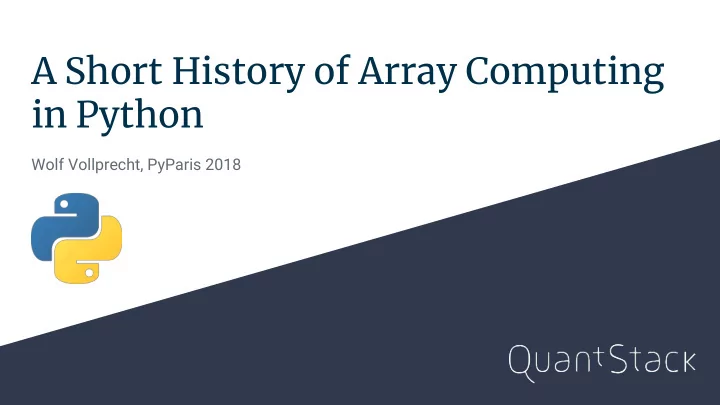

A Short History of Array Computing in Python Wolf Vollprecht, PyParis 2018
TOC - Array computing in general - History up to NumPy - Libraries “after” NumPy - Pure Python libraries - JIT / AOT compilers - Deep Learning - NumPy extension proposal
Arrays - Used practically in all scientific domains - Physics, Controls, Biological System, Big Data, Deep Learning, Autonomous Cars …
Array computing Generalize operations on scalars to … Arrays C ← A + B
What is an - memory region (buffer) - dimension n-dimensional - shape - Often strides Array? 1 el Layout Row Major (C) 0 1 2 3 0 1 2 3 4 5 6 7 8 9 10 11 Shape 3, 4 4 5 6 7 4 el’s Strides 4, 1 8 9 10 11 Layout Col Major (F) 0 1 2 3 0 4 8 1 5 9 2 6 10 3 7 11 Shape 3, 4 4 5 6 7 Strides 1, 3 8 9 10 11
1957 / 1977 Fortran 77 - One of the oldest languages for scientific computing - Still a reference in benchmarks - Original implementation of BLAS & LAPACK in Fortran - Maximum of 7 dimensions
1966 APL: Honorable Mention - Seriously dense language → Try it online: https://tryapl.org/
1987 Matlab - Proprietary software from Mathworks - Dynamic interface to Fortran - Pioneered interactive computing + visualization
1995 Numeric - Python numerical computing package - Inspired additions to Python (indexing syntax)
~2003 NumArray - More flexible than Numeric - Slower for small arrays, better for large arrays - Split in the community: - SciPy remained on Numeric...
2006: NumPy - “Merge” of Numeric and NumArray - Fast & flexible array computing in Python - Typed memory block - Notion of broadcasting - Vector Loops in C
NumPy Broadcasting - Broadcasting: what to do when dimensions don’t match up?
NumPy ufunc - Function that has specified input/output - np.sin: - nin = 1, nout = 1 - signature: f -> f, d -> d... - np.add: - nin = 2, nout = 1 - signature: ff -> f, dd -> d...
NumPy as a Standard - Computing needs have shifted - More specialized data containers needed - Parallelization, speed, GPU, data size … NumPy interface de-facto standard!
2007 numexpr - Avoid temporaries - R = A + B + C -> T1 = B + C -> T2 = A + T1 -> R = T2 - Evaluate in chunks
2007 numexpr
2014 Dask - Distributed array computing - Can handle large data - Execution of function distributed
2014 Dask
2017 pydata/sparse - Support for sparse ndarrays - Advantages - Higher data compression - Faster computation - Reuses scipy.sparse (but nD!)
2017 pydata/sparse - Store data in COO (coordinate list) model
GPUs for computation - Massively parallel - Great for large data - Cost of memory transfer from CPU → GPU - Other programming model
2015 CuPy - CUDA-aware NumPy implementation - Part of the Chainer DL framework
2017 xnd 3 libraries: - ndtypes: shape, type & memory - gumath: dispatch math functions on memory container - xnd: python bridge for typed memory
JIT & AOT compilers - Just in Time compilation for numeric code - Can give incredible speed ups
2012 Pythran - A Python/NumPy to C++ AOT compiler - Supports high level optimizations in Python - C++ implementation of NumPy with expression templates - Cython integration (Don’t miss the talk by Serge later today!)
2012 Pythran
2012 Numba - A Python to LLVM JIT - Takes Python and compiles it to Machine Code - GPU support (Cuda + AMD) - For High Performance: need to write explicit “for” loops
2012 Numba
Numba + ufunc
Numba + GPU
The AI winter is over … - Deep learning revolution - Python ecosystem benefits heavily - Lot’s of array computing
Computation Graph a = b = input c = a + b d = b + 1 e = c * d
Computation Graph - Abstraction of computation - Benefit: allows automatic differentiation - Optimization opportunities - Common Subexpression Elimination - Algebraic simplifications: (y * x) / y → (x) - Constant folding (2 * 3 + a) → (6 + a) - Fuse ops
2007 Theano - One of the first “Deep Learning” libraries - Works on a computation graph - Lazy evaluation - Compiles kernels to C & CUDA
2015 TensorFlow - Big library from Google - Killed many others (including Theano) - Same principle as Theano - At the beginning: no compilation stage
2015 TensorFlow
2015 TensorFlow + XLA - An experimental compiler for TensorFlow graphs - JIT + AOT modes - Uses LLVM under the hood
2016 PyTorch - Deep Learning Framework from Facebook - Computation Graph, but dynamic (no deferred graph model) - Easier to have control flow
PyTorch JIT & TorchScript - Subset of Python that can be compiled - Generates CUDA & CPU code
Conclusion - NumPy is the best … API - Many NumPy implementations - Many downstream projects - Pandas - xarray - scikit-..., scipy
The array extension proposal - 6 months ago started by M. Rocklin - Problem: it’s hard to write generic code - Already extension points: __array__, __array_ufunc__
The array extension proposal - E.g. CuPy input → CuPy output desired - Arguments allowed to overload __array_function__ NEP 18 numpy.org/neps/nep-0018-array-function-protocol.html
Trends ● Ecosystem has become much richer in the past years ● More compilation ● More specialized NumPy implementations ● __array_function__ will make it easy to write implementation independent code
Thanks ● Questions? Check out xtensor & xtensor-python NumPy for C++ ;) Follow me on Twitter @wuoulf or GitHub @wolfv
NumPy ufunc - Automatic broadcasting - ufunc supports: - __call__ - reduce - reduceat - accumulate - outer - inner
Recommend
More recommend